Top News
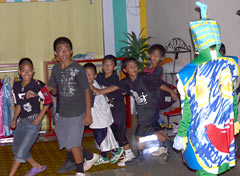
August 22, 2013 Ryukyu Shimpo
On August 18, the Obake (ghost) Night Museum was held at the Okinawa Zoo & Museum. Eight ghosts, which were selected from about 1,000 evil spirit characters created for the museum by children, appeared in the haunted house set up in the museum. Many children and their parents cautiously walked into the “haunted house.” Some children screamed and grabbed their parents.
Children and their parents who are invited to the party held by a ghost Candy Grandpa, and deliver candy gifts to him.
Ten-year-old Rusei Maeda and his five-year-old sister Miki took part in the event with their parents. They said that the ghosts popped-out from the walls and that it was really scary.
The event is held every Saturday and Sunday from 5:00 p.m. to 8:00 p.m., until September 1.
(English translation by T&CT, Hitomi Shinzato and Mark Ealey)
Go to Japanese
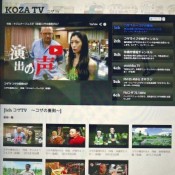
August 23, 2013 Ryukyu Shimpo
From the beginning of July, the Okinawa City Culture Tourism Division has started a virtual broadcasting station called Koza TV. Through their website they introduce events, key people and behind-the-scenes information on economic development projects in Okinawa City.
The division provides high-quality videos in cooperation with television production companies and updates the programs every Friday afternoon.
There are six channels in total. Channel One, Backstage of Koza, introduces background information about events in Okinawa City including the Peaceful Love Rock Festival and Okinawa Zento Eisa Festival. Channel Two provides live coverage of events in the city. In addition, people can access information provided by Music Town Oto Ichiba and listen to local radio programs.
The website is on the tourism portal site run by the city, KOZA WEB. Ryoichi Yonamine of the division, said, “We would like people to experience the cultural depth of Koza both directly and indirectly through the website.”
(English translation by T&CT, Lima Tokumori and Mark Ealey)
Go to Japanese
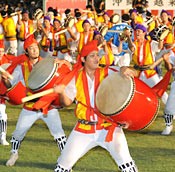
September 2, 2013 Ryukyu Shimpo
Fifteen groups took part in the final day of the 58th Okinawa Zento Eisa Festival in Okinawa City on September 1. The city is widely recognized as a symbol of eisa dance. People from inside and outside the city took part in the festival.
The crowd was entertained by a stirring eisa dance with a drum accompaniment and a glamorous variant, a women’s dance based on Ryukyu dance.
Many families and tourists from inside and outside the prefecture came to the event held at Koza Athletic Park. According to the event organizer, 310,000 visitors enjoyed the three-day festival, which included a michijune parade on August 31.
To bring the festival to a close, members of the Goeku Youth Group performed Gute eisa, a vigorous dance performed with drumbeating. Members of the Okinawan eisa taiko ensemble Ryukyukoku Matsuri Daiko performed with Tokiko Kato singing Kazeuta.
The crowd enjoyed creative eisa dances, in which regional traditions are evident. Dances unique to the various areas of Okinawa fascinated the spectators who applauded enthusiastically.
(English translation by T&CT, Mark Ealey)
Go to Japanese

Go To Video
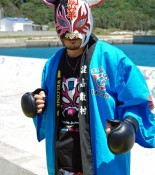
September 1, 2013 Hideaki Yoneda, correspondent of Ryukyu Shimpo
Thirty-five-year-old Tokashiki Village employee Kiyoya Toyama made his debut in a mixed martial arts event held in Matsuyama, Naha on August 25.
Fighting under the ring name Hija Devil, Toyama is the first mixed martial arts fighter from Tokashiki. He lost his bout in a close contest, but performed very well in front of about a thousand spectators.
Personifying the fighting spirit of Tokashiki, Toyama was given an award for his efforts. That he lays his life on the line to fight has attracted attention from local people and his performances help to promote Tokashiki tourism.
Toyama said, “My friend who is a world champion of martial arts, motivated me to fight. I tried mixed martial arts because you can compete at any age. I trained hard when I could get time from work and lost 13 kilograms in the process. Next time I want to win to help promote the island.” He went on to say, “Tokashiki has a boxing gym and is suitable for training of martial arts. I would really like many martial arts organizations to come to Tokashiki to hold training camps.”
Ryota Murata, who won the gold medal at the 2012 Summer Olympics in London, held a training camp in Tokashiki during his college years.
As the opening act of the event, Toru Arakaki, the head of the Kerama Drum Association of Tokashiki, and his brother performed to get the spectators ready for the show.
(English translation by T&CT, Mark Ealey)
Go to Japanese
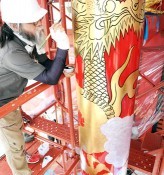
August 29, 2013 Ryukyu Shimpo
Repair work on the pillars of the Seiden (State Hall) in Shurijo Castle, which began in February, has reached the final stage. The painting of golden dragons and auspicious clouds on the pillars by craftsmen began on August 26 and will end in early September. Four pillars called kouhaibashira are in the main building that visitors face to worship in the castle. The park has been repairing the two middle pillars that have begun to deteriorate.
They replaced one that is weakening by using Japanese cypress instead of the inumaki tree that was used originally. On August 28, the craftsmen painted the outlines for the scales of the golden dragons and the auspicious clouds.
Masayuki Isa, the head of the Shuri branch of the Okinawa Memorial Park office managing Shuri Castle, said, “The renewed pillars will be in place by the fall. We want many visitors to see the pillars repaired and looking good.”
(English translation by T&CT, Mark Ealey)
Go to Japanese
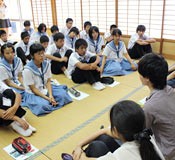
August 22, 2013 Hideyoshi Noho, correspondent of the Ryukyu Shimpo
Iheya Village held an annual course to invite students from the University of Tokyo as tutors for students in the village during summer vacation on August 10. This is the third time the village has held the course. With an opening ceremony held at the Isolated Islands Promotion Center, all local junior high school junior attended the course.
The course’s aim is encourage participants to study by interacting with students of the university considered by many people to be the most prestigious in Japan. It also encourages them to learn specific ways of studying and aims to teach how to set and achieve goals. This will be useful for students who will leave the island to take high school entrance exams.
At the ceremony, students took a competency test. Kiko Watanabe, one of the teachers, said, “I think taking high school and university entrance exams involves major changes in people’s lives. I hope that the course will provide an opportunity for the children to think about their future.”
Yuna Arakaki of Iheya Junior High School said with a smile, “I am excited that the course looks like it will be fun.”
(English translation by T&CT, Megumi Chibana and Mark Ealey)
Go to Japanese
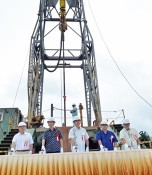
September 1, 2013 Ryukyu Shimpo
The Okinawa Prefectural Government started exploratory drilling for natural gas in Gusukubebora, Miyako on August 31.
The government plans to carry out exploratory drilling at three sites in Okinawa. To start with, they are working on the drilling in Miyako. A person involved said, “We want the project to promote the Miyako economy.”
The government held a ceremony for the project at the site with 50 people involved in the central, prefectural and city governments taking part. They prayed for the safety of the drilling work and the success of the project.
Eight companies inside and outside Okinawa including the New Energy and Industrail Technology Development Organization took part in the project. The project aims to confirm the quality of hot spring water and natural gas and conduct geological surveys. The companies plan to drill as deep as 2,500 meters by the middle of January 2014 and plan to conduct production tests by the end of that month. In parallel with the drilling work, the companies will analyze gas produced in the well fields from August 2013 to February 2014.
According to a person involved in the drilling work, they plan to conduct a full-scale geological survey of a kind never been done before. The companies said that they will be able to gain useful information on disaster prevention from the project.
In the ceremony, five people including Miyako Mayor Toshihiko Shimoji stood in front of the 38-meter high natural gas drilling tower. One of them pushed the button to start the drilling.
Mayor Shimoji said, “We have finally begun work on the drilling more than 20 years after the start of the survey. This will allow us to work on various energy-related projects such as transfer from oil to natural gas for power plants and plastic greenhouse culture by using hot spring water.”
The government plans to start exploratory drilling in Nanjo at the middle of September and in Onoyama, Naha at the middle of October.
(English translation by T&CT, Mark Ealey)
Go to Japanese
August 24, 2013 Ryukyu Shimpo
The Japanese government has filed an application to the Governor of Okinawa for permission to reclaim land off Henoko, Nago in preparation for relocating U.S. Marine Corps Air Station Futenma. The Okinawa Prefectural Government has received 3,500 statements of opinion from people involved in the issue.
Yukie Yoshikawa, a senior research fellow in the Regional Security Policy Division of the government, sent emails about the issue to around 750 people including government officials, security policy researchers and news organizations inside and outside Japan.
The representative of the division said, “U.S officials see moving the facilities at Futenma Air Station to Henoko as quite feasible. They lack information about Okinawa. It is important for us to stimulate their interest in the issue and getting them to understand the complexities involved by directly providing them with correct information.”
While the head of the Executive Office of the Governor is in charge of base issues, the head of the Civil Engineering and Construction Division reviews the land reclamation application. Yoshikawa received the approval from them and used her own network to send emails to each individual.
She sent emails in English to the people in the United States explaining developments since the Japanese government filed the application at the end of March and how they went about doing it.
Yoshikawa mentioned that Nago Mayor needs a resolution from the City Assembly when delivering his remarks on the application. She explained that the Okinawa governor will decide at the end of the year or the start of the year whether or not he will approve the reclamation. She said the governor’s decision will follow a review of the application documents, opinion from people concerned, as well as from heads of local villages, cities and governmental agencies.
(English translation by T&CT, Mark Ealey)
Go to Japanese
August 31, 2013 Ryukyu Shimpo
How long will the U.S. military continue to hide information? The latest example is the accident in which an MV-22 Osprey failed when landing in Nevada. The U.S. military provided few answers to questions from the Ryukyu Shimpo. They went no further than saying that “a U.S. Marine Corps Osprey aircraft made a hard landing during a training mission,” and that it “caught fire after the four crew members escaped injury.” They did not provide a photograph of the accident scene.
However, a spokesperson at Marine Corps Air Station Miramar commented to a local newspaper that it was damaged so much that it could no longer fly. According to aviation summaries posted on the Internet, the Naval Safety Center has determined that the accident in Nevada was a “Class A Mishap,” and the aircraft was “destroyed.” A Class A mishap involves a total cost of damage to property and aircraft of $2 million or more. Most cases in which Osprey aircraft have crashed in the past have been Class A. Judging from information from the United States, it is clear that the aircraft landed with a violent shock, was wrecked and then caught fire. This is therefore a Class A mishap causing a loss of $2 million or more.
The same as with this latest case, the U.S. military described the accident in South Korea in April in which the CH-53 helicopter that operates out of Futenma base failed to land and caught fire as a “hard landing.” Photographs of the accident site in Korea show that the helicopter was reduced to a charred wreck. What would you call this? Surely it is nothing less than a crash.
The Osprey accident that occurred in North Carolina in June was also rated as Class A. A total of $ 63 million of damage was caused, which is more than the cost of the aircraft. Marines officials commented that part of the aircraft was burnt, but we think that they were trying to hide the true seriousness of the accident.
Lt. Gen. Kenneth Glueck, Commanding General of III Marine Expeditionary Force and Okinawa Area Coordinator, said in an interview in August last year, “It’s one of the safest aircraft we have in our inventory today,” on the basis that the Osprey has had few Class A mishaps. But two Class A mishaps have happened this year, so would they still describe it as safe?
That the Osprey is a dangerous aircraft is self-evident. It cannot be allowed to fly over Okinawa any longer. The governments of Japan and the United States should withdraw all the Osprey aircraft immediately and cancel the deployment to Futenma Air Station.
(English translation by T&CT, Mark Ealey)
Go to Japanese
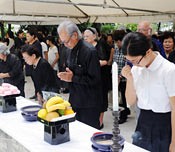
August 23, 2013 Ryukyu Shimpo
August 22 marked 69 years since the evacuation ship Tsushima-Maru carrying many schoolchildren was sunk by a U.S. submarine. At a memorial service was held at the Kozakura-no-To monument in Wakasa, Naha, about 350 people, including survivors, bereaved families, and people otherwise involved took part to pray for those who lost their lives. A children’s chorus group from the elementary schools that the victims belonged to at the time also sang.
Maria Miyagi, an 84-year-old survivor who lives in the United States participated in the memorial service. She lost her brother in the tragedy 69 years ago, “I remember it as though it happened yesterday. People were going down to the sea one after another. What happened that day is not something from a normal world,” she said. “I want to take part in the memorial service from now to pray for peace.”
Masakatsu Takara, president of the Tsushima-Maru Memorial Foundation said in his speech, “We can’t forget or forgive what happened in the Tsushima-Maru incident. From the Memorial Hall we want to strive to tell people about this tragedy to create peace and realize a society in which children can live better lives.”
A play depicting the Tsushima-Maru tragedy was performed after the memorial service to pass on its message to future generations. It conveyed the misery of the incident through song and dance.
Tokuhito Uza, a third grade student of Oroku High School and a member of the play group, said, “I want to work hard so that we can have a sense of peace in future in Okinawa.”
(English translation by T&CT, Mark Ealey)
Go to Japanese
August 20, 2013 Ryukyu Shimpo
A study group from Ehime University and Meio University has discovered high levels of toxic polychlorinated biphenyls (PCBs) in mongooses caught near U.S. military bases such as Futenma Air Station in Ginowan. Levels of PCBs in these mongooses were up to 8.9 times higher than those in other areas of Okinawa.
Researchers in the group commented on the potential danger involved, saying, “The sources of the pollution are unclear, but we believe there are distinct sources of PCB pollution near the U.S. bases. PCBs could have contaminated other creatures and residents living there.” They called for further monitoring, including inside the bases.
Professor Shinsuke Tanabe of the Center for Marine Environmental Studies of Ehime University, and Professor Yutaka Tashiro of Meio University, conducted the survey. In August and September 2008, they found seven mongooses that had been killed on the road, six near Futenma Air Station and one at the Makiminato Service Area (Camp Kinser) in Urasoe.
Tests revealed that all seven mongooses had PCBs and dioxins in their bodies. The researchers found high levels of mono-ortho PCBs, a specific type of PCB with high toxicity similar to dioxins, at a maximum of 890 nanograms and an average of 310 nanograms per gram of liver fat. Normally, less than 100 nanograms of mono-ortho PCBs would be found in creatures in the wild.
Not only is there a large difference in comparison with mongooses living in other areas of Okinawa, but the figure is ten to 100 times higher than cats, wild boars and raccoons on the main islands of Japan.
Because concentrations of other chemicals such as dioxin are at similar levels to those in terrestrial mammals in other areas, the study group hypothesizes that PCBs contaminated the mongooses near their habitat. With the small number found this time, they say it is unclear how the pollution may have affected the mongooses’ ecosystem.
Mono-orthos make up a large proportion of the PCB mixtures Aroclor 1254, Aroclor 1260, Kanechlor 500, Kanechlor 600 and others. Because of this, the study group pointed out that, “PCBs might have leaked out from transformers and capacitors around the U.S. military bases.”
The study group reported this at the Symposium on Environmental Chemistry held in Tokyo at the end of July. Out of consideration for local residents, they have not revealed where they found the mongooses.
The Makiminato Service Area stores electronic devices that include PCBs. According to a former base employee, from the 1960s, there have been cases of the U.S. military disposing of PCBs into water channels in Okinawa without taking proper measures such as purification.
Glossary: polychlorinated biphenyls (PCBs)
A type of organochlorine compound that includes chlorine in its molecules. Because of its high resistance to heat it was widely used in the insulating oil of transformers and capacitors, as well as in plasticizers and paint. Its toxicity and difficulty to decompose in nature resulted in 1970, Japan and most other countries prohibited the production and use of PCBs. Following the ban, the PCBS in transformers and other devices were disposed of improperly, and have gone missing, so the resulting leaks have become a problem for the environment.
(English translation by T&CT, Lima Tokumori and Mark Ealey)
Go to Japaense









 Webcam(Kokusai Street)
Webcam(Kokusai Street)


